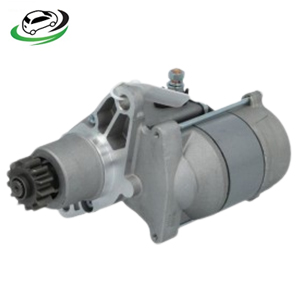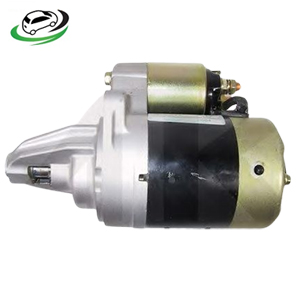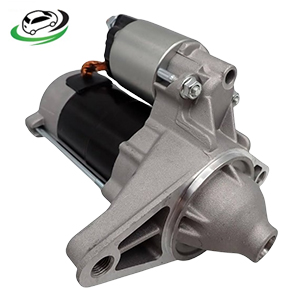-9%
Get Starter Motor Assy Toyota Corolla 1.6L 95-1999 / Toyota Celica 1.8L 94-1999 / Toyota Carina E 1.6L/1.8L 92-1998 28100-16160
The starter motor assembly is a crucial component in any internal combustion engine vehicle, playing an essential role in the engine’s starting process. Without a functioning starter motor, your vehicle simply wouldn’t be able to start, leaving you stranded. Understanding how a starter motor works, its components, and its importance can help you appreciate this small but mighty device’s engineering marvel.
The Function of the Starter Motor
The primary function of a starter motor is to initiate the engine’s operation. When you turn the key or press the start button in your vehicle, an electrical signal is sent to the starter motor. This motor then engages with the engine’s flywheel, turning it over and allowing the engine to begin its combustion process. In essence, the starter motor provides the initial momentum needed to start the engine, after which the engine’s operation becomes self-sustaining.
Components of a Starter Motor Assembly
A typical starter motor assembly is composed of several key components, each playing a vital role in the starting process:
- Electric Motor: The heart of the starter motor assembly is the electric motor itself. This motor is typically a direct current (DC) motor, designed to provide a high torque output to turn over the engine. The electric motor is powered by the vehicle’s battery, which supplies the necessary voltage to create the magnetic fields needed to generate rotational motion.
- Solenoid: The solenoid is an electromagnetic switch that serves two primary purposes. First, it acts as a relay, receiving the low-current ignition signal and sending a high-current signal to the starter motor. Second, it engages the starter motor’s pinion gear with the engine’s flywheel. When the ignition key is turned, the solenoid activates, pushing the pinion gear forward to mesh with the flywheel teeth, allowing the motor to turn the engine over.
- Pinion Gear: The pinion gear is a small, toothed gear attached to the shaft of the starter motor. When the solenoid is activated, this gear moves forward to engage with the larger flywheel gear on the engine. The pinion gear’s rotation drives the flywheel, which in turn starts the engine.
- Flywheel: The flywheel is a large, heavy gear attached to the engine’s crankshaft. It plays a crucial role in the starting process by engaging with the starter motor’s pinion gear. The flywheel’s inertia helps the engine to continue rotating once the starter motor has disengaged.
- Bendix Drive: The Bendix drive is a mechanism that allows the pinion gear to engage and disengage with the flywheel automatically. It ensures that the pinion gear only engages when the starter motor is running and disengages once the engine starts, preventing damage to the motor or the flywheel.
- Brushes and Commutator: Inside the electric motor, the brushes and commutator work together to transfer electrical current to the motor’s armature. The brushes are made of carbon and maintain contact with the rotating commutator, allowing for continuous electrical flow and motor operation.
The Starting Process
The starting process is a carefully coordinated sequence of events that begins the moment you turn the key or press the start button:
- Ignition Signal: When the ignition switch is activated, a small electrical signal is sent to the starter solenoid. This signal, though low in current, triggers the solenoid to engage the starter motor.
- Solenoid Activation: The solenoid, upon receiving the ignition signal, closes the circuit between the vehicle’s battery and the starter motor. This allows a large current to flow from the battery to the starter motor, energizing it.
- Engagement of Pinion Gear: Simultaneously, the solenoid pushes the pinion gear forward to engage with the engine’s flywheel. This is a critical step, as it ensures that the motor can transfer its rotational force to the engine.
- Motor Operation: Once engaged, the starter motor begins to rotate the pinion gear, which in turn rotates the flywheel. This action turns the engine’s crankshaft, initiating the first few engine cycles needed to start the combustion process.
- Disengagement: As soon as the engine starts, it begins to rotate faster than the starter motor. The Bendix drive mechanism automatically disengages the pinion gear from the flywheel, allowing the starter motor to stop running. This prevents the starter motor from being driven by the engine, which could cause damage.
Types of Starter Motors
Starter motors can vary in design and function depending on the vehicle type and engine specifications:
- Direct Drive Starter: This is the most common type of starter motor, where the motor’s shaft is directly connected to the pinion gear. It’s simple and reliable, making it a popular choice for most vehicles.
- Gear Reduction Starter: In a gear reduction starter, the motor’s output is passed through a set of reduction gears before reaching the pinion gear. This design allows for higher torque output with a smaller, lighter motor, making it ideal for larger engines.
- Inertial Starter: Used primarily in older or specialized vehicles, an inertial starter uses the kinetic energy of a spinning flywheel to engage the engine. It’s a less common design but still effective in certain applications.
- Permanent Magnet Starter: This type of starter motor uses permanent magnets instead of electromagnetic field coils, resulting in a lighter and more compact design. It’s commonly found in smaller or more fuel-efficient vehicles.
Maintenance and Common Issues
Like any mechanical component, starter motors can wear out over time. Common issues include:
- Worn Brushes: Over time, the carbon brushes inside the motor can wear down, reducing the motor’s efficiency or preventing it from working altogether.
- Faulty Solenoid: A failing solenoid can prevent the starter motor from receiving power or engaging the pinion gear, leading to a no-start condition.
- Bad Connections: Corrosion or loose connections at the battery or starter motor can lead to insufficient power delivery, resulting in slow or failed starts.
- Worn Pinion Gear: Repeated engagement with the flywheel can wear down the teeth of the pinion gear, leading to slippage or grinding noises during starting.
Follow us on Facebook for more parts.



